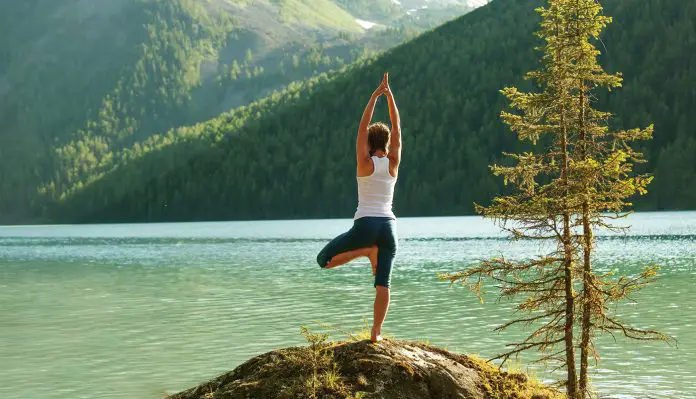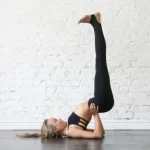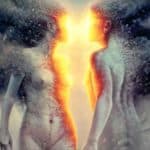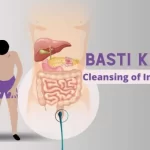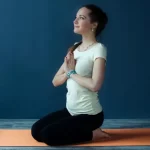Vrikshasana or the Tree Pose. What living thing do you notice that is the calmest, stillest, and most patient as you look around at the natural world? You will discover that the only living thing that possesses these attributes is a tree.
Trees are composed, patient, and firmly planted so that they may withstand every weather with the same quietness. Regardless of the weather—hot, cold, rainy, or any other—they always maintain their composure.
These characteristics of a tree are crucial to humans as well. A person needs to be composed, rooted, and unmoving. There are many ways to develop this mental trait in yoga. Vrikshasana, or the Tree Pose, is one of these techniques.
| Pronunciation | Vrik-SHAHS-ana (वृक्षासन) |
| Meaning | Vries – Tree Asana – posture |
| Pose Type | Standing and balancing pose |
| Pose Level | Beginner – Hold 1 minute on each leg |
| Focus Muscles | Feet, ankles, thighs, chest, and shoulders |
Vrikshasana – The Tree Pose
One of the well-known standing and balancing poses in Hatha yoga is called Vrikshasana. One of the 32 asanas listed in the Gheraasahit, it is.
This yoga pose, in contrast to the majority of them, is performed with eyes open. We perform this asana with our eyes open since it calls for us to keep our entire body balanced on one foot. Here, we have only one leg and are standing tall and straight like a tree.
In this pose, our bodies resemble trees or trees in attitude (Vriksha). As a result, we refer to it as Tree Pose or Vrikshasana.
To bring the divine river Ganga to Earth, it is said that the great sage Bhagirath performed Tapasya (penance) at Vrikshasana for a thousand years. This fact alone demonstrates the importance of this asana.
How to Do the Tree Pose
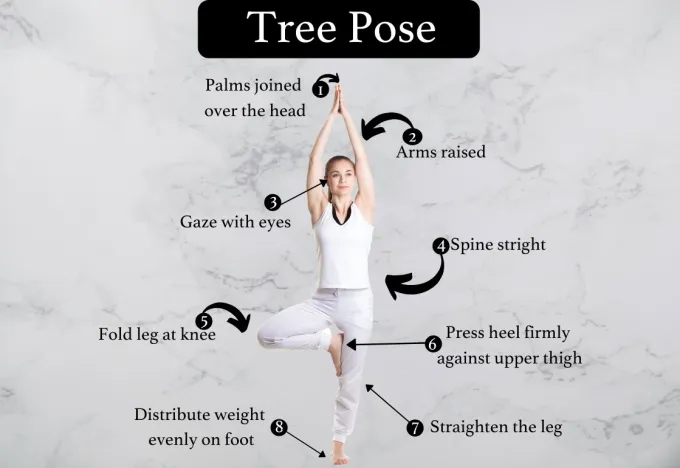
Stand straight on one leg, bending the right leg and placing the right feet on the left thigh: standing thus like a tree on the ground is called Tree Posture” – Gheranda Samhita 2.36
Vrikshasana is fairly simple to perform. You can simply strike the following poses by taking the steps listed below:
Steps
- Stand straight and tall, as in Tadasana.
Getting Into the Vrikshasana
- Bend the right leg at the knees while in tadasana and position the heel of the right leg at the base of the left leg’s thigh. Your toes should be pointed down, and your sole should be flat and firmly pressed against your thigh.
- Weight should be properly distributed across the left foot’s toe balls, heels, and inner, and outer surfaces.
- Straighten your arms now and elevate them above your head. Then clasp your hands together, palms facing upward. The hands will be raised in the Namaste position.
- Gaze straight and concentrate on a single thing. Breathe deeply for the flow of Prana in your body
Hold the position for 30-60 seconds, according to your comfort.
Coming Out of Vrikshasana
- When finished, split your palms and lower your arms.
- Right now, slowly straighten your right leg and relax. All of this must be done while exhaling. You will return to Tadasana at this point.
You raised your right leg and kept your left leg straight throughout the process described above. Repeat it now with your left leg raised and your right leg straight after a few breaths.
The entire procedure must be done five times with the right leg and five times with the left leg.
Imagine that you are a tree. Your feet are firmly planted on the earth, and your head is turned toward the light. Be as composed and firmly planted as a tree.
Feel the bliss of the asana’s quiet and tranquillity. Imagine your foundation and feel the uplifting energy of your roots.
Beginner’s Tip
If you’re just starting out, you might find it challenging to keep your balance on one foot. So, in this situation, you can use the wall’s assistance. Simply do this asana while standing in front of a wall and using the wall for support.
It is difficult to plant your foot at the upper thigh at first. The lower thigh of the other leg is where your foot should be, thus that is acceptable.
Avoid Vrikshasana under the Following Conditions:
- A person experiencing headaches, migraines, or sleeplessness.
- Someone who recently suffered an injury to their back, shoulders, arms, or legs.
Don’ts for Vrikshasana
- Avoid extending your leg too far. Recognize your body’s limitations and adjust your stretching accordingly.
- Never rest the elevated leg’s sole on the knee of another leg. At the very least, put it on the lower thigh.
- Avoid bending your spine in the front or the rear. Keep it extended out and straight.
Vrikshasana(Tree Pose) Benefits
Vrikshasana teaches us to balance our body and mind because it is primarily a balancing pose. It enhances brain processes and aids in preserving the body’s equilibrium, serenity, and calmness. These are some of its physical and spiritual advantages.
Physical Benefits
- It works a variety of body muscles, enhancing the body’s general flexibility.
- This pose gently extended the spine, enhancing its strength and flexibility.
- The thighs and calves are stretched in this asana. It strengthens the leg muscles and tones the feet’s ligaments and tendons.
- As the Tree Pose tones the muscles of hips and hamstrings, so, its regular practice prevents pain in these areas such as Sciatica [efn_note] what is sciatica https://www.mayoclinic.org/diseases-conditions/sciatica/symptoms-causes/syc-20377435?page=0&citems=10 [/efn_note]
- It maintains the body balance equally throughout the whole foot, therefore, it is helpful in curing Flat Feet [efn_note] What is flat feet https://www.medicalnewstoday.com/articles/168608#what-are-flat-feet [/efn_note].
- With the shoulders and arms actively used this asana tones and strengthens those muscles.
- Practitioners of Vrikshasana must open their chests. It aids in appropriate diaphragm expansion, which in turn aids in normal breathing.
What are the Health Benefits of Vrikshasana (Tree Pose)?
The exercise known as Vrksasana (Tree Position) combines balance, stability, strength, stretch, and a full attention operation. The advantages of this exercise when performed properly are detailed below.
- Stretches lengthen and strengthen the muscles in the arms, shoulders, legs, hips, back, and core with Vrksasana. When performing poses like the Half Lotus Tree Position (Ardha Padma Vrksasana), the Half Chair Position (Ardha Utkatasana), and others, this hip opener aids in maintaining stability in the pelvic girdle.
- Flexibility and range of motion: The hip, knee, ankle, and shoulder joints are all involved in this balancing stance, which helps to maintain the body steady. With practice, the hips’ lateral rotation, the knee’s extension, and the shoulders’ upward rotation prepare for countermovements in other poses including Natrajasana (the dancer’s position), Garudasana (the eagle position), and Utthita Hasta Padangusthasana (the standing hand to big toe position). As a result, over time, practicing the tree position helps to improve the mobility of the affected joints and muscles, serving as a warm-up for other positions.
- Chest, Diaphragm, and Breath: When performing the Tree Position exercise with the arms extended upward, the chest, rib cage, diaphragm, and intercostal muscles are all actively used (breathing muscles). The active utilization of these requirements to increase air intake into the lungs also checks the lungs’ routine use. However, yoga instructors might instruct some persons to hold their hands in the Anjali Mudra at their chest if lifting their arms above their heads is difficult for them (Namaskar Mudra). Breathing also improves with the cogent use of the diaphragm and lungs, which has an effect on stability and balance while in the position.
- Yoga teaches that paying attention to your breath can assist in uniting body and mind and establish a state of physiologic equilibrium. Awareness and Focus (Concentration) People maintain a straight gaze throughout the situation. It promotes mindfulness. People should direct their awareness first to their pelvis and shoulders because this is the thrust of the pose in order to realize the delicate balance between strength and balance. The awareness can shift to altering the body’s legs, core, back, and arms to complete the posture once the pelvis is stabilized. Improved application and focus over time can help build confidence in other difficult balancing positions.
- Alignment and Posture: Maintaining this posture while maintaining balance without interfering with the prana flow is important, as is having a clear understanding of the alignment aspects. The placement of the foot in the groin, the external movement of the hips and knees, the five toes’ grounding action with all of them pointed anteriorly, the positioning of the hips and pelvis, the alignment of the shoulders with the hips and foot, and the raised hands with the shoulders and hips all work together to complete the position and yield the greatest benefit. When they are all present, the position is attractive and balancing is made simpler. With continued activity, the spine stretches and becomes solid and aligned, which contributes to general excellent posture.
- Balance and Emotion: Your mental health is significantly more crucial than your physical abilities when it comes to teaching balance. If you are anxious or distracted, your body is likely to become disoriented. The Tree Position can be considered a form of meditation since it promotes harmony between the physical body and the mental state of mind. By directing all of the emphasis to breathing, desk yoga, or adolescent yoga (counting the chair variation), can help you relax and destress.
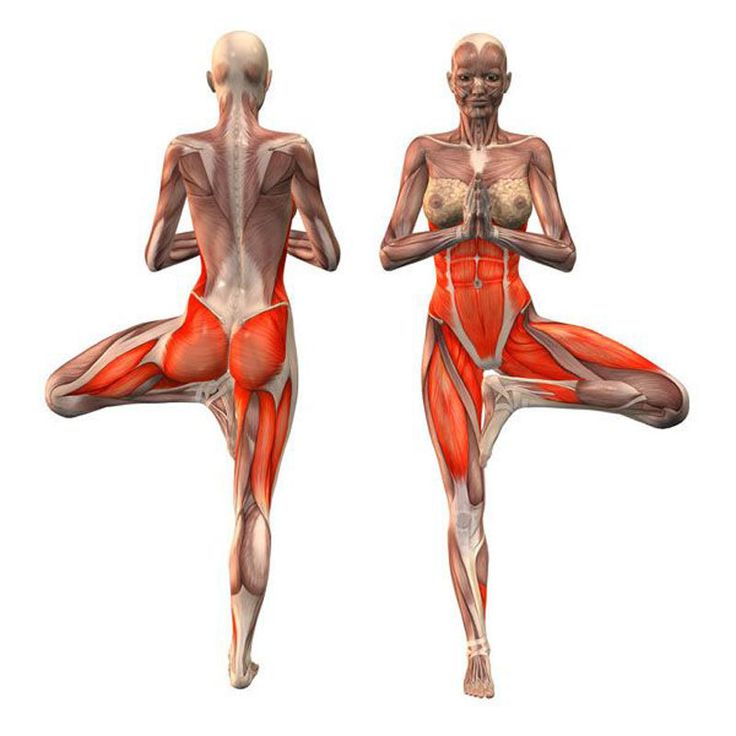
- Energizing, de-stressing, and relaxing: Since the majority of joints and muscles, particularly the chest, core, back, and pelvis, are used during the exercise of Vrksasana, the flow of energy (prana) is increased. The nervous system is calmed, the mind is directed, and the body’s unwanted energy is expelled through the manipulation of breath. An abundance of prana can easily move to the moderate part of the body thanks to the outflow of undesired energy (Apana Vayu). When one is standing beneath a tree, the increased prana flow promotes inner calmness and equilibrium in the body-breath-mind. It teaches people how to be anchored without being stiff, and how to be strong while also being flexible.
- Stimulation and Organs: The Third Eye Chakra, which is considered the seat of innate wisdom and creativity, is activated by holding the gape at one point during a contemplative pose (people can also be encouraged to practice this with their eyes closed if that is more comfortable for them). The Root Chakra, which governs stability and dependability, is stimulated by the pressure on the lower back and spine and by the grounding action of the pelvis and foot. The internal organs are stimulated at a fine level by the core muscles’ alluring effects. A hip opener’s presence combined with the pelvic appeal also affects the reproductive system, aiding in the birth of infertile women and regulating hormone levels.
- Benefits for Women: Produces a lightness-like feeling that is advantageous during menstruation or pregnancy. Stretching the calves during pregnancy aids in preventing leg stiffness and restlessness.
- Preparatory Pose: Following mastery of the Tree Position, further challenging positions such as Tree Position Side Bend, Tree Position Side Bend Hand Foot, and Revolved Tree Position Elbow To Knee, to mention a few, can be practiced.
Spiritual Benefits
- Through the stretch and contraction of the region at the base of the spine, Vrikshasana increases the flow of prana to the Mooldhara Chakra region. Thus, it helps to stimulate Mooldhara Chakra.
- It soothes the brain’s nerves and improves your mood.
- It gradually increases the confidence and self-esteem of the practitioner.
















